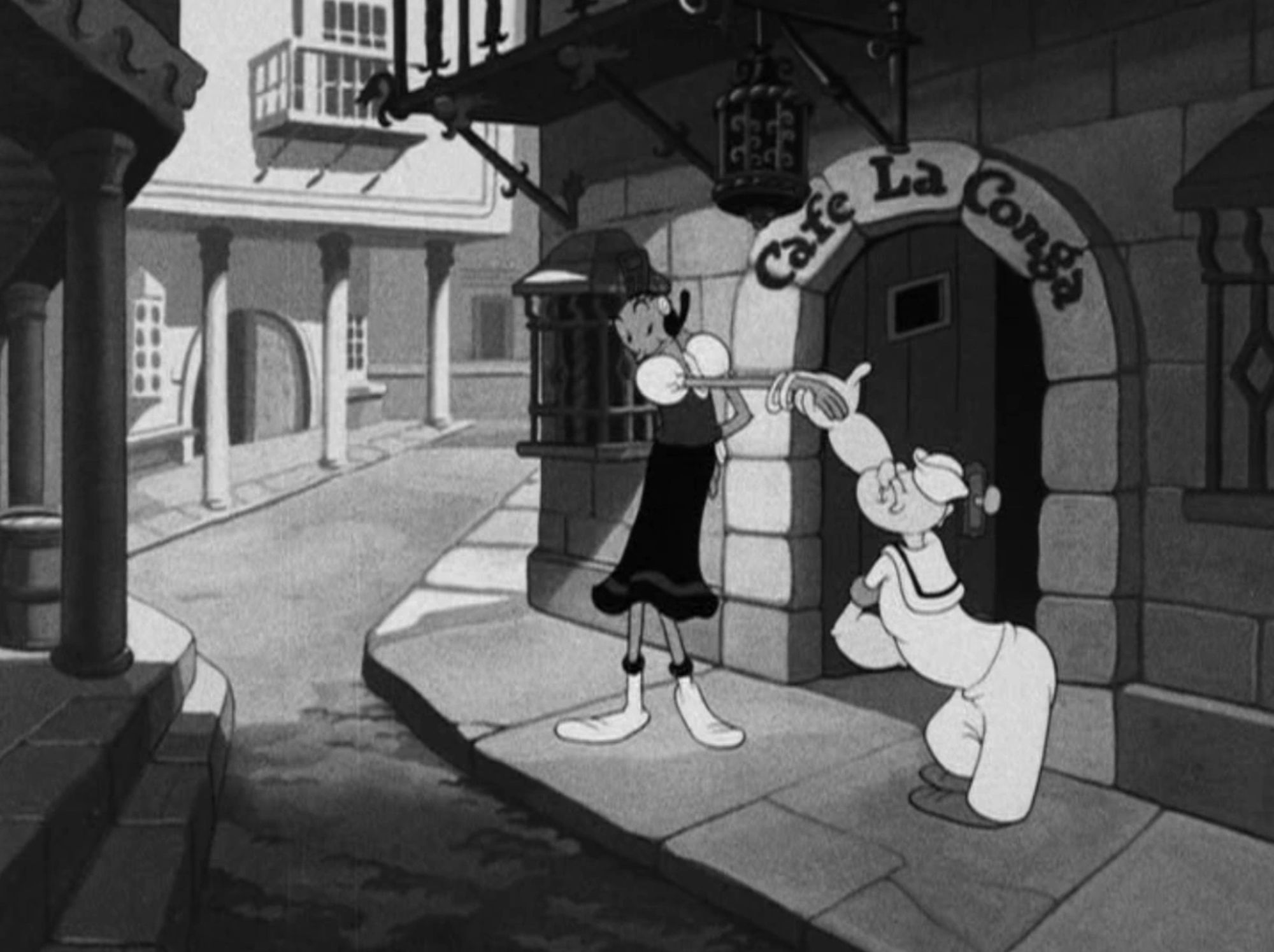I’m Popeye the sailor man / I’m Popeye the sailor man
I’m strong to the fin-ich / Cause I eats me spin-ach
I’m Popeye the Sailor Man
Written in 1933 by Samuel “Sammy” Lerner for a seven-minute and thirty-seven second cartoon, one that included a guest appearance by the Fleischer studios’ favorite kewpie doll, Miss Betty Boop, this catchy little ditty introduced audiences to the crusty but goodhearted Popeye. His seeming gruffness and slender build masked an underlying urge to defend the weak and the helpless — the kind of jolt that Depression-era audiences were longing for.
And, boy, oh boy, was he ever strong. Those ham-fisted forearms of his packed quite a punch, even without his green-colored power snack. He certainly got around a lot, too. But most fans would expect that from a seafaring adventure seeker, what with the country’s shifting priorities during wartime superseding most other activities. Join the Navy, see the world! That’s the ticket! Oh, and while you’re at it, have fun with the locals.
As sure as Lady Liberty’s torch would light up New York harbor, our hearty sailor lads, Popeye and the boorish Bluto, along with other cartoon characters, were recruited by the major studios to star in period-flavored shorts in support of the war effort. This took place in the early to mid-1940s.
Even more strategic for the Roosevelt Administration was its implementation of the so-called Good Neighbor Policy, or, as it was known in Brazil, A Política de Boa Vizinhança. This policy, administered by the Office of Inter-American Affairs and placed in the willing hands of a young magnate named Nelson Rockefeller, was established as a means of bringing Latin countries closer to the American fold — and away from Nazi and/or Fascist influence.
Brazil, a nation almost the size of the Continental U.S., and the largest one south of the border, represented a huge, untapped market and business challenge. Yet despite its growing coffee and steel mill production, the Great Depression, and now the war, continued to hamper Brazil’s efforts in other key areas — infrastructure and primary goods among them — to include her ability to address those lingering concerns.
Distraction from both the reality of rationing and the lack of basic services had become almost as viable an alternative for the locals as it had been for North Americans. While one of these diversions, i.e., the burgeoning movie industry in Brazil, was still in its infancy, many Brazilians had gotten hooked on film-watching (especially those from America) as far back as the silent era.
My father, as frequent and knowledgeable a moviegoer as they come, spent a good portion of his youth at the Saturday afternoon matinee. Similar to what transpired up north, the matinee ritual would start (in wartime) with civil defense announcements, followed by a newsreel or two, some Movietone shorts, and the inevitable cartoons — all of this coming before the main attractions, typically defined by the letters “A” and “B” (as in the “A” and “B” features).
As an unique form of recreation, cartoons began to reach their peak in the U.S. both during and after the 1930s. However, not every bold endeavor was rewarded with commercial lucre. In 1939 the Max and Dave Fleischer studios, which had earlier profited from the iconic Koko the Clown and Betty Boop series, alongside their well-received Popeye output, decided to move the animation unit from their cramped New York headquarters to a sprawling Miami, Florida complex. Cheaper labor, better working conditions, avoidance of growing union unrest, and a fresher outlook overall were what the Fleischer brothers had in mind.
Unfortunately, the dearth of available talent, and the brothers’ inability to compete with Disney and his innovative team of artisans, remained a hindrance to the Fleischers’ success. With the failure of their full-length features Gulliver’s Travels (1939) and Mr. Bug Goes to Town (1941), the studios’ distributor, Paramount Pictures, decided to cut their losses and pull up stakes. Paramount also severed ties to the Fleischers themselves, who lost control of their workshop after a two-decade run.
Under the re-branded Famous Studios moniker (a reference to its forbearer Famous Players) , Paramount brought the animation business back to the Big Apple. Whatever staff members were left standing (or sitting, as the case may be) and willing to take the relocation plunge to Midtown, would continue to plow their trade in an area relatively close to their original locale. Among the survivors were Sam Buchwald, the fellow in charge; lead animator Seymour Kneitel, who happened to be married to Max Fleischer’s daughter; and story man Isadore “Izzy” Sparber. Both Kneitel and Sparber alternately took over the reins of Popeye’s continuing adventures, in addition to those of that other Man of Steel, the mighty Superman.
“Kickin’ the Conga Round” (1942)
A month and ten days after Pearl Harbor, the Fleischers’ most popular creation, Popeye, was summoned for active duty. Released on January 17, 1942 — and as one of the studio’s first Good Neighbor-themed shorts — the lively Kickin’ the Conga Round (in inky black-and-white) has our mumbling, squinty-eyed seaman (Jack Mercer) accompany that rotund heavy, Bluto (Dave Barry), to an unidentified Caribbean port. It seems the boys took the “have fun with the locals” advice to heart.
(Note: Due to the origin and nature of the conga, however, this Caribbean port and the idyllic story-setting could only have been situated in Cuba. Also, with the studios’ relocation to the Sunshine State, the subsequent close proximity to and growing influence of the Latino community could not have been overlooked).
Popeye is pining away at a reflection on his chest tattoo: It’s a portrait of a dark-skinned beauty, La Señorita “Olivia Oyla” (voiced by Margie Hines, in her best ZaSu Pitts impression, with an ersatz Spanish accent). But his best bud Bluto beats him to the punch with plans of his own: He steals the lovely lady’s phone number (CONGA 1-2-3) in order to book her for a date, but pronto. Armed with this tidbit, Bluto makes a beeline for the exit, forcing his pal to miss the boat for shore leave. Round one goes to Bluto.
At an outdoor dining area, Bluto entertains Ms. Oyla with silly parlor tricks. Just then, Popeye shows up and gains the upper hand by outdoing Bluto with some tricks of his own. Popeye leaves his “buddy” with a huge head bump and dark shiner, thus winning the second round. Our hero is now free to escort his date to the Café La Conga.
At the club, Olivia insists he dance the conga with her, but Popeye balks at the request. Taking full advantage of his friend’s reluctance, Bluto reappears and politely invites Olivia to do the conga with him. In seconds, Olivia jumps into the waiting Bluto’s arms; they’re sweeping each other off their feet in a laughably-exaggerated dance display (more in the nature of a Parisian Apache Dance). Popeye can only sit and brood, his little pipe boiling over at the sight of his girl being tossed around like a rag doll.
In that moment, a waiter walks by with a fresh can of spinach for the sorry-eyed salt to sample. Popeye gulps the contents down in no time. With that, the re-energized sailor man turns into a conga-strutting dynamo. Shoving that show-off Bluto to the side, Popeye makes quite an impression on Ms. Oyla — to the point that as they whip up a storm on the dance floor, an enraged Bluto decides to cut in, only to be pummeled by Popeye.
A veritable free-for-all ensues, as both sailors forget their manners and go at each other’s throats, shot for shot, punch for punch. Also forgotten in the melee is an irate Ms. Olivia Oyla, who runs off to seek assistance. While the rivals are knocking one another about, two shore patrol guards (or SP’s) arrive on the scene. They grab the two offenders (who they refer to as “Jeebs,” a period slang term) and march them off to the brig — each guard kicking the rear ends of their prisoners to the beat of the conga. The winner and still champion: the shore patrol. Certainly, the Café La Conga won’t have these two sailor boys to “kick around” anymore.
Needless to say, friendly Inter-American relations took a few noticeable steps backward with this entry into the Good Neighbor sweepstakes. Still, there are some pleasant (if sometimes violent) moments to savor. Bluto is surprisingly light on his feet, with the flatfooted Popeye equally dexterous (allowing for the timely aid of his spinach, of course). In one sequence, the sailor physically up-ends himself — that is, his arms and hands replace his legs and feet, which continue the conga moves in tandem. The pacing throughout the feature is swift, the gags witty and light.
Musically, arranger Sammy Timberg has the session players strike the main conga motif in a repetitive TA-ta-ta-ta-ta-TUM, TA-ta-ta-ta-ta-TUM rhythm. There’s no real melody as such, only a rapidly-pulsed theme similar to the cha-cha (also of Cuban origin) but to a quicker conga step. Which is just as well, since the music fits the occasion and the cartoon’s purpose of furnishing an atmospheric backdrop.
Credits — Direction: Dave Fleischer, a common practice at the time, although there is no indication he actually directed the piece; animators: Thomas Johnson, George Germanetti, and Frank Endres; story: Bill Turner, Tedd Pierce (credited under Ted Pierce); music: Sammy Timberg.
(End of Part One)
Read Part Two Here: https://www.brazzil.com/animated-brazil-part-two-wont-you-be-my-good-neighbor/
Copyright © 2023 by Josmar F. Lopes










